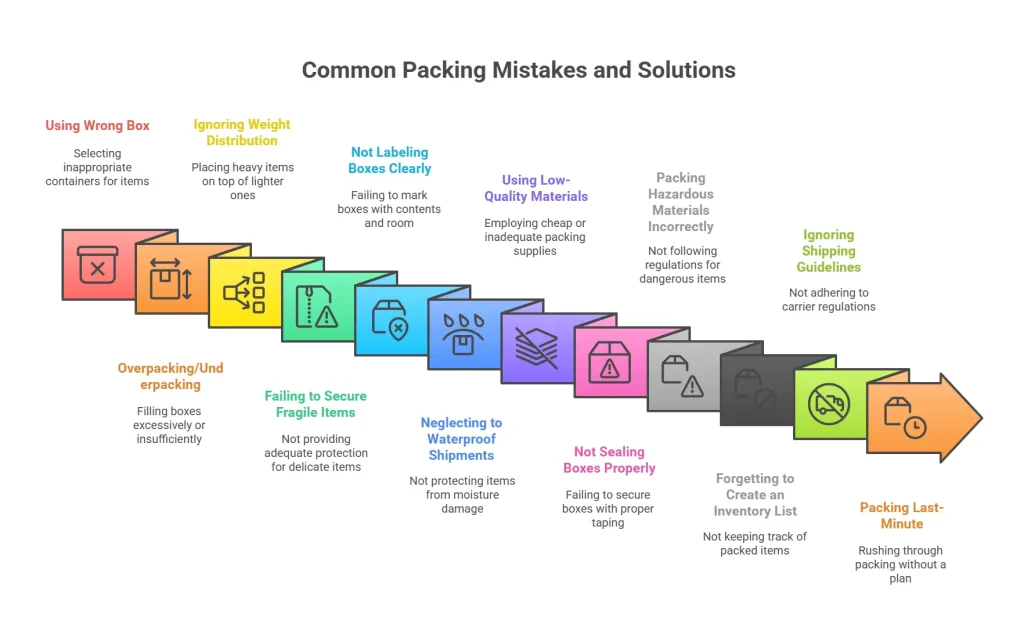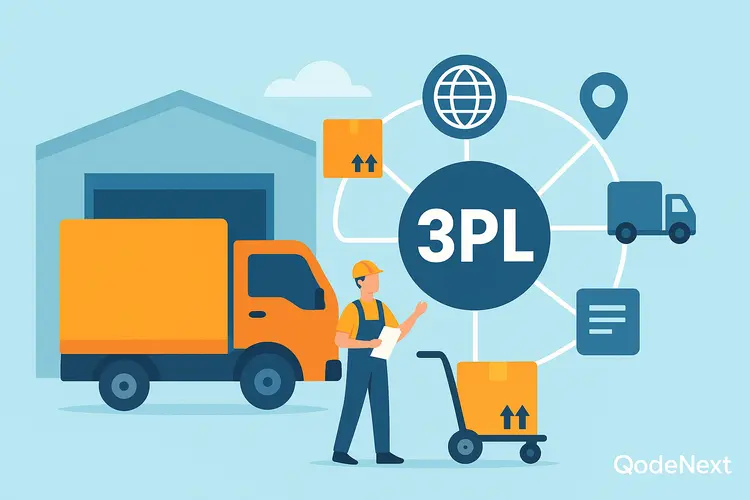Packing may seem like a simple task, but even a small mistake can lead to damage, delays, or additional expenses. Whether you are preparing for a vacation, moving to a new home, or shipping products for your business, avoiding common packing mistakes is crucial. In this comprehensive guide, we will explore frequent errors, their impact, and how you can ensure a seamless packing experience.

Why Is Logistics Packing Important?
Packing plays a crucial role in logistics, directly impacting the efficiency, cost, and safety of transportation. Whether shipping goods domestically or internationally, proper packing ensures that products reach their destination intact and on time. Here’s why packing is essential in logistics:
1. Protects Goods from Damage
In logistics, goods go through multiple handling stages, including loading, unloading, and transportation. Without proper packing, items are vulnerable to breakage, moisture damage, or contamination. Using sturdy boxes, protective materials like bubble wrap, and appropriate sealing methods reduces the risk of damage.
2. Enhances Supply Chain Efficiency
Efficient packing allows for better space utilisation in storage facilities and transport vehicles. Well-packed items are easier to stack, reducing wasted space and optimising freight capacity. This leads to cost savings and smoother operations across warehouses, distribution centers, and last-mile delivery services.
3. Ensures Compliance with Shipping Regulations
Different regions and carriers have specific packaging requirements, especially for hazardous materials, perishables, and fragile items. Proper packing ensures compliance with these regulations, preventing fines, shipment delays, or rejected parcels. This can also help you reduce shipping costs in the long-run.
4. Improves Brand Reputation
For businesses, the condition of received packages influences customer perception. Well-packed goods reflect professionalism, while damaged deliveries can lead to customer complaints, refunds, and loss of trust. Investing in quality packing materials enhances customer satisfaction and strengthens brand credibility.
5. Reduces Transportation Costs
Optimised packing minimises shipping costs by reducing package weight and volume. Proper cushioning also prevents returns due to damage, saving businesses money in the long run.
11 Common Packing Mistakes to Avoid

1. Using the Wrong Type of Box or Container
One of the most common packing mistakes is using an inappropriate container for your items. Weak or oversized boxes can collapse, while undersized ones may not provide adequate protection.
How to Avoid:
- Choose sturdy, high-quality boxes suited for the weight and size of your items.
- For fragile goods, opt for double-walled boxes.
- Use plastic bins for long-term storage to prevent moisture damage.
2. Overpacking or Underpacking Boxes
Overpacking a box can cause it to burst open, while underpacking can leave items moving around, increasing the risk of breakage.
How to Avoid This Packing Mistake
- Distribute weight evenly across multiple boxes instead of cramming everything into one.
- Fill empty spaces with cushioning materials like bubble wrap, packing peanuts, or crumpled paper.
3. Ignoring Weight Distribution
Packing heavy items on top of lighter ones is a recipe for damage. This often happens when people rush to fit everything into a box without considering weight distribution.
How to Avoid:
- Place heavier items at the bottom and lighter ones on top.
- Use smaller boxes for heavy items to prevent excessive strain. Implement warehouse packing procedures to minimise disruptions.
4. Failing to Secure Fragile Items Properly
One of the worst packing mistakes is not giving fragile items enough protection. Glassware, electronics, and ceramics require special care.
How to Avoid:
- Wrap each fragile item individually in bubble wrap or foam.
- Use dividers for glassware to prevent direct contact.
- Mark boxes as “FRAGILE” and use arrows to indicate the correct orientation.
5. Not Labeling Boxes Clearly
Unlabeled or poorly labeled boxes can cause frustration during unpacking or shipping.
How to Avoid:
- Label each box with its contents and the room it belongs to. Use smart labels for a hassle-free process.
- Use color-coded stickers for quick identification.
- Mark special handling instructions, such as “This Side Up” or “Handle with Care.”
6. Neglecting to Waterproof Shipments
Moisture can destroy clothing, electronics, books, and even packaging materials.
How to Avoid:
- Wrap items in plastic bags or waterproof coverings before placing them in boxes.
- Use plastic bins instead of cardboard when packing for long-term storage.
- Seal boxes with high-quality packing tape to prevent moisture seepage.
7. Using Low-Quality Packing Materials
Cheap or inadequate packing supplies can lead to damage. Weak tape, thin wrapping paper, and substandard boxes compromise protection.
How to Avoid:
- Invest in strong packing tape, durable boxes, and high-quality cushioning materials.
- Avoid reused boxes that have weakened over time.
8. Not Sealing Boxes Properly
If a box is not sealed correctly, it may open during transit, leading to lost or damaged items.
How to Avoid:
- Use the H-taping method (sealing all edges and seams).
- Apply at least two layers of strong packing tape.
- Reinforce box corners with extra tape if needed.
9. Packing Hazardous Materials Incorrectly
Certain items, like batteries, aerosols, and flammable liquids, have strict packaging and shipping regulations. Failing to follow these guidelines can result in delays or penalties.
How to Avoid:
- Research regulations before shipping hazardous materials.
- Use proper labels and approved containers for transportation.
10. Forgetting to Create an Inventory List
An inventory list ensures that nothing is lost or misplaced during packing and unpacking.
How to Avoid:
- Keep a checklist of packed items. Use an automated warehouse packing equipment to eliminate bottlenecks.
- Assign numbers to boxes and list their contents for easy reference.
11. Ignoring Shipping Guidelines and Restrictions
When shipping items, failing to adhere to carrier regulations can result in rejected shipments or additional fees.
How to Avoid:
- Check carrier guidelines for weight, dimensions, and restricted items.
- Ensure all necessary customs declarations are included for international shipments.
12. Packing Last-Minute Without a Plan
Rushing through packing often leads to mistakes, missed items, and unnecessary stress.
How to Avoid:
- Start packing well in advance.
- Pack non-essential items first and keep daily-use items accessible.
- Have a step-by-step packing plan to stay organised.
Conclusion
Avoiding packing mistakes is essential for ensuring the safety and efficiency of your move, shipment, or storage process. By using the right materials, planning, and following best practices, you can prevent damage, minimise stress, and streamline the packing experience. Whether you’re relocating, shipping products, or preparing for a trip, following these guidelines will help you pack like a pro.
For further assistance in warehouse and supply chain strategies, get in touch with Qodenext today.
FAQs – Packing Mistakes
1. What is the most common packing mistake?
The most common packing mistake is failing to protect fragile items adequately. Without proper cushioning, breakables can easily get damaged during transport.
2. How do I choose the right box for packing?
Select a box based on the weight and fragility of the items. Use sturdy, appropriately sized boxes, and reinforce them with strong packing tape.
3. Why is labeling boxes important?
Labeling boxes helps with easy identification, speeds up unpacking, and prevents mishandling of fragile or sensitive items.
4. How can I prevent overpacking?
Distribute weight evenly among multiple boxes and avoid exceeding the recommended weight capacity of each container.
5. Which is better for storage: plastic or cardboard boxes?
Plastic bins are ideal for long-term storage, as they offer better protection against moisture and pests. However, high-quality cardboard boxes are sufficient for short-term use.







